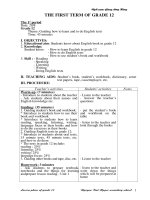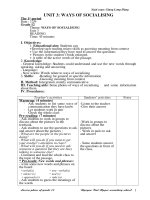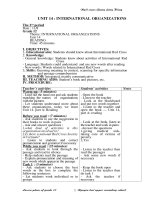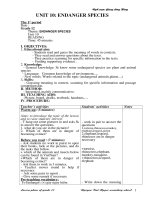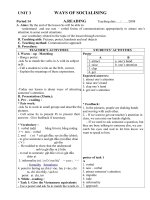ANH 12 CB UNIT 9
Bạn đang xem bản rút gọn của tài liệu. Xem và tải ngay bản đầy đủ của tài liệu tại đây (251.68 KB, 10 trang )
UNIT 9 : DESERTS
Period 55 A. READING Teaching date..//2009
A. Aims : By the end of the lesson Ss will be able to:
- understand the passage about deserts and scan for specific information.
- use vocabulary related to the topic of the lesson through exercises.
B. Teaching aids: Textbook, posters, pictures.
C. Teaching method: Communicative approach .
D. Procedure:
Teachers Activities Students Activities
I. Warm up ( 5 Min.) Game : Animal in
hiding
- Get Ss to work in group ; Deliver handouts
with the following sentences and ask them to
find the animals hiding in the sentences.
Ex: Close the door at once ! -> rat
1. That will be a real help.
2. She came late every day.
3. He came to America today.
4. Eric owes me ten cents.
5. Do good workers succeed?
6. If Roger comes, well begin.
7. In April I only came once.
8. Ill sing; you hum on key.
9. She clothes naked baby.
10. At last, I, Gerald, had won.
Lead in : Which kind of these animal can live
in deserts ?
II. Presentation ( 35 Min.)
1, Pre reading
a, Pair work :Discuss the questions in
textbooks
Ask Ss to work in pair.
Call some pairs to give the answers.
Give comments.
b, Vocabulary :
- desert (n) ['dezt] : large area of land without
water and trees often covered with sand.
- northerly (adv/ adj) in or toward the north.
- eastward (adv. adj) toward the east
- corridor (n):[ 'krid:]long narrow passage of
land running through territory of another state.
- stable (adj.) ['steibl] firmly fixed, not easy to
change
2, While - reading :
a. Task1: Give the Vietnamese equivalents
Expected answers:
1. That will be a real help. -> bear
2. She came late every day. -> camel
3. He came to America today. -> cat
4. Eric owes me ten cents. -> cow
5. Do good workers succeed? -> dog
6. If Roger comes, well begin. -> frog
7. In April I only came once. -> lion
8. Ill sing; you hum on key. -> monkey
9. She clothes naked baby. -> snake
10. At last, I, Gerald, had won. -> tiger
Expected answers:
1. They are dry, hot. Dunes are around deserts.
2. Camels, scorpions, cactus.
3. Australia, China, Egypt...
Poster Matching
A (English) B (Vietnamese)
1. stretch a. thổ dân úc
2. sandy b.kho sỏt trên không
3. 'aerial survey c. kéo dài, căng ra
4. Royal Geographical d.đỉnh , nóc
Society of Australia e.đụn cát. cồn cát
5.Australian Aborigine f.cỏ lá nhọn
6. dune g. dốc
7. slope h. gò , đống
to the following words or phrases
- Ask students to read through the text once to
find out some new words, guess the main idea.
- Ask Ss to read the passage silently, stop
when they meet a new word or a phrase and
find words or phrases in the passage which
have the following meaning given in the Task
1.
- Hang a poster , ask Ss to match.
- Gives feedback.
b. Task 2: Decide whether the following
statements are true (T) or false (F):
- Guides Ss the way to do Task 2 and ask them
to work in pairs
- Gets Ss to check theirs answers and explain
their choices.
- T calls some Ss to read theirs answers and
explain their choices.
- T comments and gives feedbacks.
c. Task 3: Answer the following
questions
- Asks Ss to read the passage silently and
answer the questions individually
- Asks Ss to work in pairs to compare their
answers.
- Calls on some Ss to write the answers on the
board.
- Checks with the class.
- Gives feedback.
3. Post – reading : Discuss the question “
Which method should people use to stop
desert expansion ? )
- Ask Ss to discuss in groups.
- Call some Ss to present their ideas.
- Give comments.
III. Consolidation and Homework ( 5 Min.)
- Learn by heart all the new words.
- Do the task 3 again.
- Prepare part B
8. stable i. Hội địa lí Hoàng Gia Úc
9. hummock j. cát
10. crest k. dốc
11. spinifex m. ngược đứng(dốc)
Feedback
1- c; 2 – j ; 3 – b ;4 – i ; 5 – a; 6 – e ; 7 – k ; 8 – m ;
9 – h ; 10 – d ; 11 – f
Feedback(Task 2)
1. F ( ...three great stretches of sandy deserts....)
2. F (Simpson is not the largest one. The largest is
the Gibbon, Great Sandy and the Tanami Deserts)
3. T (Until Madigan made an aerial survey in
1929, he ...)
4. F (Colson and Australia Aborigine)
5. F ( .... northern....)
6. T (In the northern .... dry salt lakes ....)
Feedback(Task 3)
1. There are Great Victoria Deserts, Gibbon, Great
Sandy, Tanami deserts and Simpson Deserts.
2. It lies between Lake Eyre in the south, the
MacDonnell Ranges in the north, the Mulligan and
the Diamantia Rivers in the east and the Macumba
and Finke Rivers in the west.
3. In 1845
4. He was the president of the South Australian
Branch of the Royal Geographical Society of
Australia.
5. They took camels across the desert.
6. In the west part, they are short, mostly less than
10 meters high, and in the northern part, they are
parallel and are up to 20 meters high.
7. two. They are hummock grasses and spinifex.
Suggested ideas :
- ban people from cutting down trees for fuel and
farmland ( because when they cut down trees, the
climate and soil are affected and forests are turned
into deserts.
- plant a wall of trees across the edge of a desert to
stop desert sand from spreading.
-build long canals or pipelines to carry water to
desert area.
Goodbye!
Period 56 B. SPEAKING Teaching date…../……/2009
A. Aims: By the end of the lesson Ss will be able to:
- list some kinds of trees and animals living in deserts and talk about natural features of
deserts
- express their ideas about trees and animals living, natural features of deserts
B. Methods: Communicative approach
C. Teaching aids : Textbook, posters, pictures, ….
D. Procedures:
Teacher’s Activities Students’ Activities
I. Warm – up ( 5min.) : Network
- Ask Ss to find out as many words as possible
and point out what animals and plants might
live in deserts.
Cactus
→ Introduces the new lesson: In today’s
speaking lesson, you’ll practice talking about the
natural features of a desert.
II. Presentation ( 35Min.)
1. Pre – speaking
Task 1 : Check the trees and animals .....
Activity 1 :Vocabulary
- eucalyptus (n) [,ju:kə'liptəs] (pl) :
eucalyptuses, eucalypti
cây khuynh diệp, cây bạch đàn
- lizard (n) ['lizəd] con thằn lằn
- cactus (n) [ 'kæktəs]; (pl) cacti['kæktai]
cây xương rồng
Activity 2 : Pair work
- Ask Ss to choose the trees and animals and
give the reasons why they can live in a desert.
Expected answers:
- camel
- banana
- horse
- buffalo
- dog
- grass
- spinifex
- hummock grass
- date palm
.........
* Animals and plants can live in deserts: camels,
lizards, desert fox, some kinds of birds cactus ,
date palm....
Sample conversation:
A: What animals can live in a desert?
B: I think they are camels.
A: Why can they live in a desert?
B: Because they can exist without food and
water if they need to. When they eat, they store
fat in their humps. They can drink as much as
water and store in a small flash – shaped bags
Plants and animals
2. While – speaking
Task 2 : Finding out the natural features of
a desert.
- Have Ss to work in pairs to find out as many
natural features of a desert as possible .
- Tell Ss to compare their results with other
pairs.
- Call on some Ss to present their ideas.
- Give feedback.
3. Post – speaking
Task 3 : Some important things :
- Put Ss into groups.
- Tell Ss they are going to travel across the
desert.
- Ask them to suggest some important things
they should bring along with them in the journey
and explain the reason of their choice.
- Call on some groups to present their choices.
- Give feedback and make comments.
III. Consolidation & Homework ( 5 Min.)
-Write a short paragraph about the natural
features of a desert. ( What and how is it
formed ? )
that line inside of their stomach.
A: What kind of trees can live in a desert?
B: I think it is cactus
A: Why can cactus live in a desert?
B: Because when it rains, water is stored in its
stem and it never loses its leaves.
feedback.
- There is no water in a desert.
- It’s a hot , dry and sandy place.
- There are few animals and plants living in a
desert.
- It has arid climate.
- Little rain falls in deserts.
- Some deserts can be cold for most of the year.
Generally, the seasons are dry.
Feedback
- I thing we should bring a lot of food and water.
They can help us to survive in the desert if we
get lost.
- In my opinion, I think we should bring a large
hat and sun block to protect ourselves from the
heat and sunlight.
- A box of match is very necessary for us to
make a fire at night.
Goodbye!
Period 57 C. LISTENING Teaching date…../……/2009
A. Aims : By the end of the lesson, the students will be able to:
- To practice students’ speaking and listening skills.
- To help students to guess the meaning of some words and do the task given in order
to understand the listening about deserts
B. Methods: Integrate, Communicative approach
C. Teaching aids : Textbook, posters….
D. Procedures:
Teacher’s Activities Students’ Activities
I. Warm – up ( 5 Min.) Jumble words
- Ask Ss to put the words in the correct order.
TEREDS
*Lead – in : Our lesson will focus on some
features of desserts and how they are formed .
II. Presentation ( 35 min.)
1. Pre-listening:
a. Pair work : Discuss the questions
- Ask Ss to work in pair .
- Call some Ss to answer in front of the class.
- Correct and give feed back
b. Vocabulary
- Explains unfamiliar words to students
* frightening speed : tốc độ nhanh đến khủng
khiếp
* canal [kə'næl] kênh, sông đào
* needle ['ni:dl] lá kim (lá thông, lá tùng)
* agent (n) ['eidʒənt] tác nhân; chất
2. While – listening:
A, Task 1 : T/ F statements:
- Ask students to spend 2 mins to read all the
statements, underline the important words and
guess which sentence is true and which is false.
- Play the record once again and ask students to
do the task .
- Ask students to work in pairs to exchange their
answers
- Ask some students to read aloud their answers
- Listen and give remarks. T can play the record
again if students cannot give correct answers
B. Task 2 : Answer the questions :
- Have Ss work in pairs.
- Ask the Ss to try to answer the questions.
Expect word
DESERT
- Desert is a dry, hot and sandy place.
- It is formed by nature and the act of humans.
- Human can make deserts. They destroy the soil
and environment , step by step, the soil becomes
desert.
- Read through the statements and underline key
words
- Listen to the tape
- Do the task individually and compare the
answers
Feedback:
1. T ( Nothing is soft.)
2. F ( Some kinds of plants can grow in deserts.)
3. T (Time and space seem endless in a
desert.)
4. F ( Nature and humans cause the change...)
5. T ( They eat every plant they can find.)


